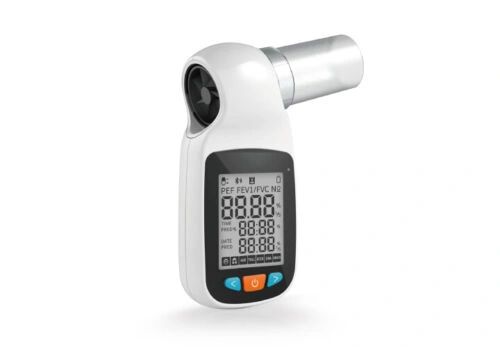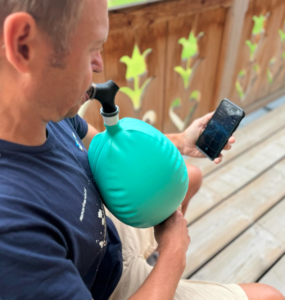Spirometry is a crucial diagnostic tool used in assessing lung function. As a practitioner or coach, understanding the basics of spirometry can be valuable, especially when dealing with athletes and their respiratory health and performance. This guide aims to provide you with a step-by-step approach to performing spirometry accurately.
I. Understanding Spirometry:
1. Definition:
Spirometry is a pulmonary function test that measures the volume of air an individual can inhale, how much they can exhale, and how quickly this can be done. It is commonly used to diagnose and monitor respiratory fitness, conditions, and illness.
2. Equipment:
– Spirometer: This device measures the amount of air exhaled in a single maximal breath.
– Nose clip: Prevents air leakage through the nose during the test.
– Mouthpiece: The part of the spirometer that the individual breathes into.
II. Preparing your athlete for Spirometry:
1. Medical History:
Gather information on the individual’s medical history, especially any respiratory conditions, acute or chronic injuries that might impact the test.
2. Rest:
Advise the individual to rest peacefully for 15 minutes prior to testing to ensure baseline respiratory status.
3. Explain the Procedure in Detail:
Begin by explaining the spirometry procedure to the individual. Ensure they understand the importance of the instructions for accurate results.
II. Performing Spirometry:
1. Calibration:
Calibrate the spirometer according to the manufacturer’s instructions to ensure accurate readings.
2. Positioning:
– Ask the individual to sit comfortably in an upright position.
– Position the spirometer so that the individuals hand is not blocking the vent hole and so you can see either the LED indicator light or the screen.
– Attach a nose clip to the individual to prevent air from escaping through the nose.
3. Instructions for the Athlete:
– Instruct the individual that they will take a maximally deep breath in and then exhale forcefully. They will continue exhaling until their lungs are completely empty.
– Even though they will feel empty after 1-2 seconds, instruct them to continue to squeeze every last millilitre of air out of their lungs until the spirometer indicates that the measurement is complete (for most portable spirometers, this is 6 seconds).
5. Performing the Test:
– Have the individual take a slow maximal inhalation before they put their lips on the mouthpiece.
– Coach them to produce a rapid and forceful exhalation into the spirometer until their lungs are empty.
6. Repetition:
– Repeat the test three times to ensure consistency in results.
IV. Interpreting Spirometry Results:
1. Key Parameters:
– Forced Vital Capacity (FVC): The maximum volume of air forcefully exhaled after a maximal inhalation.
– Forced Expiratory Volume in 1 second (FEV1): The volume of air exhaled in the first second of the FVC.
– FEV1/FVC Ratio: The ratio of air exhaled in the first second compared to the total volume of air moved in single maximal effort. This result is usually recorded as a percentage.
2. Normal Values:
– Compare the individual’s results to age, sex, and height-specific normative values as published.
– Reference the Isocapnic spirometry calculator on the Isocapnic companion app. (available March 2024).
3. Abnormalities/Interventions:
– Reduced FEV1/FVC ratio may indicate a functional strength limitation or if extremely low, asthma or chronic obstructive pulmonary disease (COPD), or other medical condition. To improve FEV1/FVC ratio, focus on STRENGTH and COORDINATION sessions using the Breathe Way Better app and training programs.
– Reduced FVC with a normal FEV1/FVC ratio may suggest a restricted or under developed respiratory range of motion. To improve FVC, focus on VOLUME and ENDURANCE Breathe Way Better sessions and programs.
**Always consult a physician if you are concerned about your spirometry results.
Conclusion:
As a coach or practitioner, having a basic understanding of spirometry can enhance your ability to assess an athlete’s respiratory system as a potential performance limitation. Regular monitoring can contribute to better overall performance and health. Remember to collaborate with healthcare professionals for a more in-depth analysis of results and appropriate medical interventions if needed.




